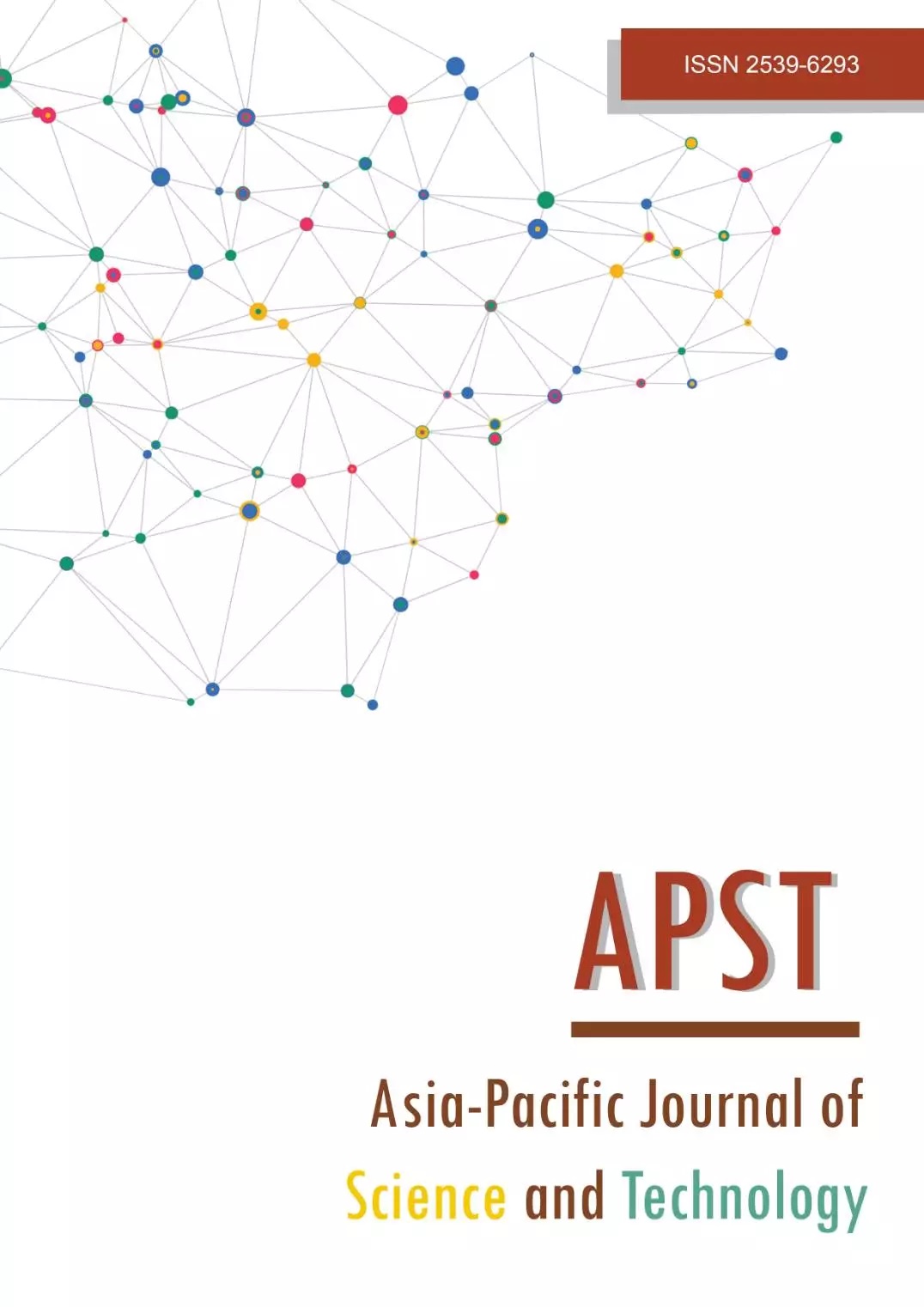Coating of seasonings in deep-fried banana chips by electrostatic and non-electrostatic coating processes
Main Article Content
Abstract
Deep-fried banana chips were coated with seasonings, salt, sugar, and mixed paprika flavor. The coating methods employed electrostatic coating (varying the voltages from 30 to 50 kV), in comparison with non-electrostatic coating. Physical properties of the seasoning powders, adhesion, and coating evenness of the powders and the target foods (banana chips) were evaluated. It was found that particle size, z-potential and apparent density values of the seasoning powders varied depending on their types. In general, electrostatic coating enhanced coating performances as evidenced by high adhesion and coating evenness percentages. Coating of banana chips with sugar and mixed paprika flavor, both processes, provided greater adhesion and coating evenness than those of salt coating. Electrostatic voltages affected the adhesion and coating evenness, depending on seasoning types. Electrostatic coating influenced starch digestibility by either increased or retarded the digestion rate, depending on the quantities of seasonings adhered to the target foods.
Article Details

This work is licensed under a Creative Commons Attribution-NonCommercial-NoDerivatives 4.0 International License.
References
Huang Y, Barringer SA. Adhesion of food powders with nonelectrostatic and electrostatic coating. J Food Process Eng. 2012;35:264-277.
Amefia AE, Ali AJM, Barringer SA. Improved functionality of food additives with electrostatic coating. Innov Food Sci Emerg Technol. 2006;7:176-181.
Biehl HL, Barringer SA. Physical properties important to electrostatic and nonelectrostatic powder transfer efficiency in a tumble drum. J Food Sci. 2003;68:2512-2515.
Rao SN, Barringer SA. Calcification of diced tomatoes by liquid dipping versus electrostatic powder coating. J Food Process Preserv. 2006;30:71-78.
Kerr WL, Kerr CA. Electrostatic spraying of potassium sorbate for the reduction of yeast and molds on cakes. J Food Process Preserv. 2015;39:2171-2179.
Meng X, Zhang H, Zhu JJ. Characterization of particle size evolution of the deposited layer during electrostatic powder coating processes. Powder Technol. 2009;195:264-270.
Ratanatriwong P, Barringer SA, Delwiche J. Sensory preference, coating evenness, dustiness, and transfer efficiency of electrostatically coated potato chips. J Food Sci. 2003;68:1542-1547.
Sumonsiri N, Barringer SA. Effect of powder and target properties on wrap around effect during coating. J Food Sci. 2010;75:E537-E543.
Reyes C, Barringer SA. Evenness of seasoning measured by image analysis, colorimetry and sensory evaluation. J Food Process Preserv. 2005;29:369-377.
Srikaeo K, Arranz-Martínez P. Formulating low glycaemic index rice flour to be used as a functional ingredient. J Cereal Sci. 2015;61:33-40.
Halim F, Barringer SA. Electrostatic adhesion in food. J Electrostat. 2007;65:168-173.
Srikaeo K, Khamphu S, Weerakul K. Peeling of gingers as evaluated by image analysis techniques: A study for pickled ginger process. Int Food Res J. 2011;18:1387-1392.
Sopade PA, Gidley MJ. A rapid in-vitro digestibility assay based on glucometry for investigating kinetics of starch digestion. Starch‐Stärke. 2009;61:245-255.
Goñi I, Garcia-Alonso A, Saura-Calixto F. A starch hydrolysis procedure to estimate glycemic index. Nutr Res. 1997;17:427-437.
Barringer SA, Sumonsiri N. Electrostatic coating technologies for food processing. Annu Rev Food Sci Technol. 2015;6:157-169.
Prasad LK, McGinity JW, Williams III RO. Electrostatic powder coating: Principles and pharmaceutical applications. Int J Pharm. 2016;505:289-302.
Marsalek R. Particle size and zeta potential of ZnO. APCBEE Procedia. 2014;9:13-17.
Ali FS, Base TE, Inculet II. Mathematical modeling of powder paint particle trajectories in electrostatic painting. IEEE Trans Ind Appl. 2000;36:992-997.
Biehl HL, Barringer SA. Comparison of the effect of powder properties on coating transfer efficiency and dustiness in two non-electrostatic and electrostatic systems. Innov Food Sci Emerg Technol. 2004;5:191-198.
Peltonen J, Murtomaa M, Robinson K, Salonen J. The electrical resistivity and relative permittivity of binary powder mixtures. Powder Technol. 2018;325:228-233.
Aykas DP, Barringer S. The effect of temperature, lecithin content and voltage on droplets/cm2 during electrostatic spraying of oil. J Food Process Preserv. 2014;38:484-492.
Bailey AG. The science and technology of electrostatic powder spraying, transport and coating. J Electrostat. 1998;45:85-120.
Ebrahimi E, Mollazade K, Arefi A. An expert system for classification of potato tubers using image processing and artificial neural networks. Int J Food Eng. 2012;8:9.
Matiacevich S, Cofré DC, Silva P, Enrione J, Osorio F. Quality parameters of six cultivars of blueberry using computer vision. Int J Food Sci. 2013;419535.
Srikaeo K, Mingyai S, Sopade PA. Physicochemical properties, resistant starch content and enzymatic digestibility of unripe banana, edible canna, taro flours and their rice noodle products. Int J Food Sci Technol. 2011;46:2111-2117.
Srikaeo K, Sopade PA. Functional properties and starch digestibility of instant Jasmine rice porridges. Carbohydr Polym. 2010;82:952-957.
Jyothi AN, Sasikiran K, Sajeev MS, Revamma R, Moorthy SN. Gelatinisation properties of cassava starch in the presence of salts, acids and oxidising agents. Starch‐Stärke. 2005;57:547-555.


